Birdfinding.info ⇒ The charming, cartoonish Sea Parrot, as some call it, is locally common along the rugged coasts where it breeds, mainly in Iceland, Norway, Ireland, and Scotland. In the U.S. it can be seen in summer in coastal Maine near its breeding colonies, such as Eastern Egg Rock, Seal Island and Machias Seal Island; and on winter pelagic trips out of ports south to Virginia Beach, Oregon Inlet, and Hatteras. Flybys are sometimes seen from seawatch points in New England including Cape Ann and Race Point.
Atlantic Puffin
Fratercula arctica
Breeds on North Atlantic and arctic coasts; winters at sea in the North Atlantic.

Approximate distribution of the Atlantic Puffin. © Xeno-Canto 2022
Breeding. Breeds from March to September in large colonies, nesting in burrows on sea cliffs and islets along the coasts of northeastern North America (locally from southeastern Ellesmere Island and northern Quebec south to Maine), western Greenland, Iceland, Jan Mayen, Bear Island, Svalbard, Novaya Zemlya, northern Scandinavia, Faeroes, the British Isles, and Brittany.
Adults return to colonies from March to May, depending on the latitude, and lay their eggs from April to June. Juveniles depart in August and September.
In 2015, the European population was estimated at 4,770,000 to 5,780,000 pairs, which accounts for over 90% of the global population. Of the Europeans, about 50% breed in Iceland, 20-25% in Norway, ~12% on the British Isles, and ~10% on the Faeroes.
Much smaller numbers breed in northeastern North America, Greenland, France, and Russia.

Atlantic Puffins at a breeding colony. (Gull Island, Witless Bay Ecological Reserve, Newfoundland; June 30, 2017.) © Pavel Parkhaev
Nonbreeding. Winters at sea, mostly far offshore, across upper latitudes of the North Atlantic north to Labrador, Iceland, and Norway, and south to North Carolina, northern Morocco, and the western Mediterranean (east to the Balearic Sea).
Smaller numbers winter irregularly up the St. Lawrence River as far as Quebec City, and at sea south to Bermuda, the Azores, and the Canaries—with a few winter records from each of these areas.
Exceptional vagrants have been recorded from Florida, Western Sahara, Italy, and interior locations in eastern North America (e.g., specimen collected at Toledo, Ohio on November 17, 1980).
Identification
The only puffin in its range, and therefore immediately recognized by its ornate bill, black-and-white plumage, and stocky, bull-headed physique.
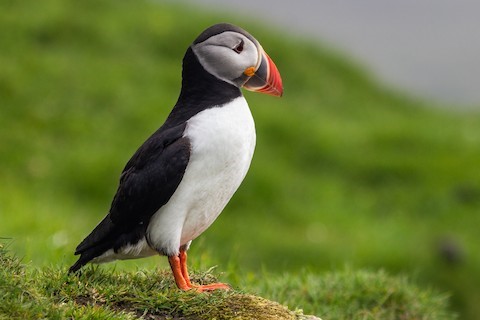
Atlantic Puffin. (Hermaness National Nature Reserve, Shetland Islands, Scotland; June 15, 2019.) © Ramit Singal
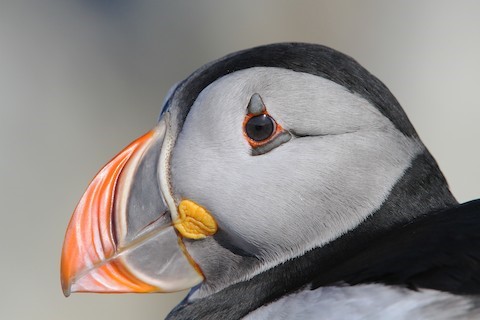
Atlantic Puffin. (Hornøya, Vardø, Finnmark, Norway; April 5, 2011.) © Christoph Moning
Breeding adults have a keel-shaped, laterally compressed bill with an exceptionally deep base and convexly curved, almost semicircular profile. The outer half is orange, the inner half is dark bluish-gray, divided by a pale yellowish crescent. The bill’s most decorative elements are temporary growths that are shed and regrown annually.

Atlantic Puffin. (Seal Island National Wildlife Refuge, Maine; June 3, 2018.) © Keenan Yakola
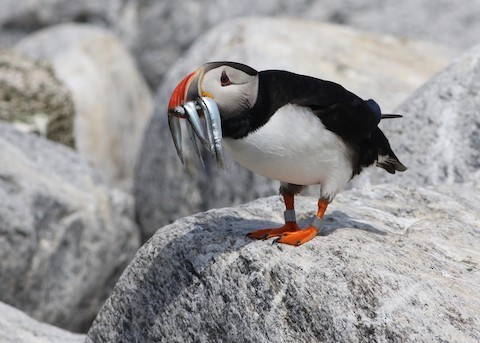
Atlantic Puffin, carrying fish back to the burrow. (Seal Island National Wildlife Refuge, Maine; July 3, 2017.) © Keenan Yakola
Breeding plumage is crisply defined: all-black upperparts contrast with all-white underparts. The face is all-white (or shaded gray), framed by black above and below. The black neck forms a collar between the white chest and face.
Nonbreeding plumage is similar to breeding, except that the face is mostly blackish or smoky-gray. The bill loses its ornate plating and becomes noticeably narrower and more pointed when viewed in profile. It usually retains a dull-orange color toward the tip, with a dark base.
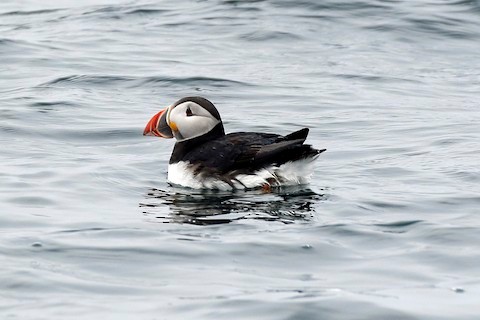
Atlantic Puffin in breeding plumage. (Seal Island National Wildlife Refuge, Maine; June 23, 2018.) © David McQuade

Atlantic Puffin in nonbreeding plumage. (Offshore from Oregon Inlet, North Carolina; February 28, 2021.) © Ed Corey
Immatures resemble nonbreeding adults but have all-dark bills that are even narrower in profile—and could therefore be confused with a Razorbill.
In flight, the underside of the wing appears all-dark, and the black collar is prominent.
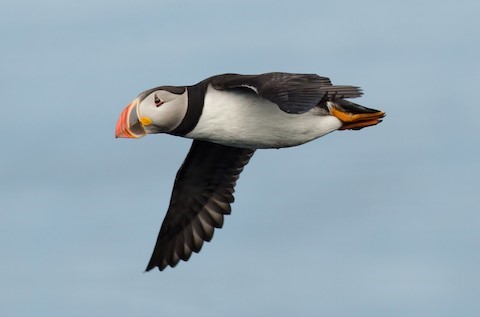
Atlantic Puffin in breeding plumage—note the prominent black collar. (Green Island, Nova Scotia; June 27, 2015.) © Alix d’Entremont

Atlantic Puffin, immature—note the prominent black collar and the dark, narrow, pointed bill. (Offshore southwest of Bermuda; March 10, 2021.) © Chris Burville
Voice. Calls include deep moans, murmurs, mutters, and growls: Some calls bear uncanny resemblances to chainsaws and loudly creaking door-hinges:
Notes
Polytypic species consisting of three recognized subspecies.
Additional Photos of the Atlantic Puffin
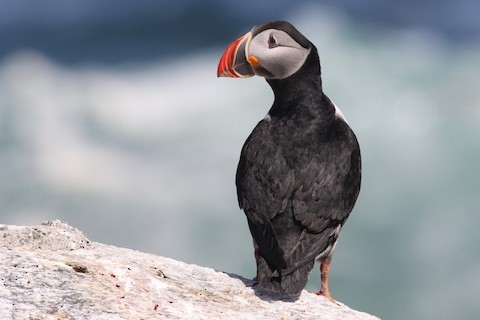
Atlantic Puffin. (Seal Island National Wildlife Refuge, Maine; June 3, 2018.) © Keenan Yakola

Atlantic Puffin. (Machias Seal Island, Maine; June 22, 2006.) © David Hollie

Atlantic Puffin. (Farne Islands National Nature Reserve, Northumberland, England; July 25, 2017.) © Joshua Brown
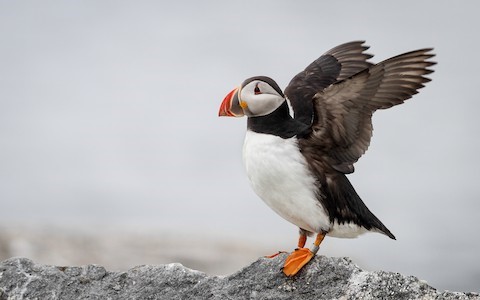
Atlantic Puffin. (Eastern Egg Rock, Maine; June 16, 2015.) © Fyn Kynd
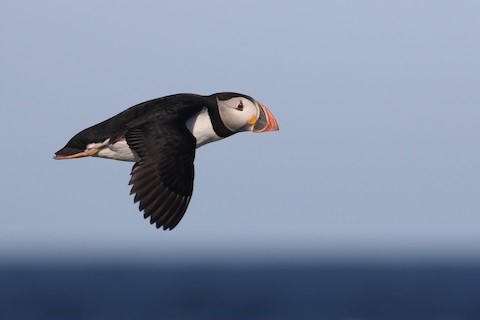
Atlantic Puffin. (Seal Island National Wildlife Refuge, Maine; June 3, 2018.) © Keenan Yakola

Atlantic Puffin. (Hornøya, Vardø, Finnmark, Norway; April 5, 2011.) © Christoph Moning

Atlantic Puffin. (Heimaey, Suðurland, Iceland; August 9, 2019.) © Caleb Putnam
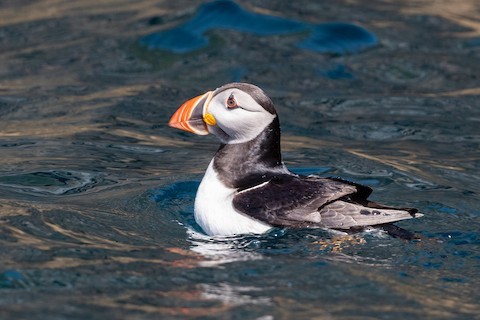
Atlantic Puffin. (Runde, Møre og Romsdal, Norway; June 24, 2019.) © Hans Norelius

Atlantic Puffin in nonbreeding plumage. (Offshore from Oregon Inlet, North Carolina; February 16, 2020.) © Peter Flood
References
Alderfer, J., and J.L. Dunn. 2014. National Geographic Complete Birds of North America (Second Edition). National Geographic Society, Washington, D.C.
BirdLife International. 2018. Fratercula arctica. The IUCN Red List of Threatened Species 2018: e.T22694927A132581443. https://dx.doi.org/10.2305/IUCN.UK.2018-2.RLTS.T22694927A132581443.en. (Accessed January 15, 2022.)
eBird. 2022. eBird: An online database of bird distribution and abundance. Cornell Lab of Ornithology, Ithaca, N.Y. http://www.ebird.org. (Accessed January 15, 2022.)
Gaston, A.J., and I.L. Jones. 1998. The Auks: Alcidae. Oxford University Press.
Harrison, P. 1983. Seabirds: An Identification Guide. Houghton Mifflin, Boston.
Howell, S.N.G., and K. Zufelt. 2019. Oceanic Birds of the World. Princeton University Press.
Sibley, D.A. 2014. The Sibley Guide to Birds (Second Edition). Alfred A. Knopf. New York.
Svensson, L., K. Mullarney, and D. Zetterström. 2009. Birds of Europe (Second Edition). Princeton University Press.
Xeno-Canto. 2022. Atlantic Puffin – Fratercula arctica. https://xeno-canto.org/species/Fratercula-arctica. (Accessed January 15, 2022.)
